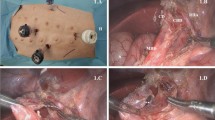Abstract
Introduction: Despite use of intraoperative cholangiography (IOC), only one-third or less of bile duct injuries that occur during laparoscopic cholecystectomy are detected at the primary operation. Therefore, there is a need to investigate other intraoperative diagnostic methods, especially laparoscopic ultrasound, for detecting bile-duct injuries. Materials and methods: Detection of different bile-duct injuries by laparoscopic intraoperative ultrasonography was evaluated in a blind, randomized animal study. Fifty bile-duct injuries were created using laparoscopic techniques in 23 pigs. The number of single lesions and the order in which the injuries were created was randomly assigned. The lesions created were: (1) partial occlusion by a clip, (2) complete occlusion by a clip, (3) partial laceration, (4) transection without clips, (5) transection between clips and (6) excision between clips. In addition, there were cases without lesions. Different types of clips were used. A screening of the injuries by laparoscopic ultrasound using a flexible probe was attempted. The study was performed in a blind fashion. Results: Complete ultrasonographical imaging of the hepatic and common bile duct between its bifurcation and its insertion into the duodenum was accomplished in all 23 animals before surgery was performed. Eight cases without lesions were correctly recognized. In 48 of 49 cases, the injuries were detected (sensitivity 98%). In one instance, the injury was obvious without the use of ultrasound. Forty-four cases were correctly diagnosed and, in 12 cases, the injuries were equivocally differentiated (specificity of 100%, overall accuracy of 98.3%). There was only one false diagnosis. The different types of clips were also reliably differentiated. Conclusions: We conclude that laparoscopic ultrasonography can reliably visualize most relevant bile-duct injuries. A standard for doing the ultrasound examination is proposed. Direct and indirect ultrasound signs of bile-duct injuries are explained.
Similar content being viewed by others
Author information
Authors and Affiliations
Additional information
Received: 3 February 1999 Accepted: 14 May 1999
Rights and permissions
About this article
Cite this article
Birth, M., Roblick, U., Brugmans, F. et al. Laparoscopic ultrasonography reliably visualizes bile-duct injuries – a blind randomized porcine study. Langenbeck's Arch Surg 384, 360–365 (1999). https://doi.org/10.1007/s004230050214
Issue Date:
DOI: https://doi.org/10.1007/s004230050214




